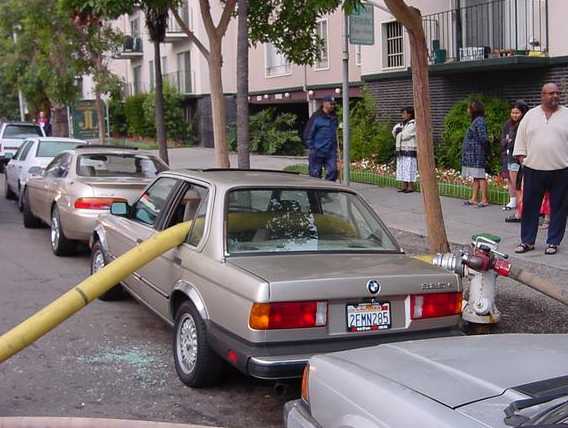
hat tip to steve
Update: the text originally published here had little to do with the above image. The picture is complete unto itself, a visual one-liner, not requiring a word of explanation or elucidation. (Except that it's a great bit of real-life performance art.) Unfortunately the photo was "vibrating badly" with the one below it on the page, to use curator Walter Hopps' term for two unharmonious paintings in an exhibition hanging. He would sometimes substitute a lesser picture next to the one he considered the masterpiece to remedy this. On the blog another solution is to have a "text buffer"--some random snippet that insulates the two images from each other. Unfortunately including text in the same blog post (out of sheer laziness of not wanting to create an intervening buffer post, which is an involved process) inevitably invites relating such text to the image above it. It was hoped that Paul Virilio's thoughts about "the accident" (yanked from Wikipedia and now moved to the comments) could be read ironically in tandem with the firehose picture, since what it depicts is not an accident--but that's asking a lot in a fast-reading blog scenario. Thanks to K for noting the problem. This meta type text now serves as the buffer. blah blah
Be that as it may, the picture depicts not the result of an accident but rather the extreme of unfavorable possible outcomes for some doofus who was testing his luck with the Parking Gods. From this angle you can't tell, but I bet even money there's also a ticket on the windshield for parking in front of a hydrant.
fire dept street justice.
I was being ironic. This is no accident. (Actually I mainly needed a text buffer between the pics in this and and previous post and the passage about Virilio sounds cool.). I suppose the fire could be the accident and BMW collateral damage, inexorable as dawn.
Moved text (see update):
(filler) Technology cannot exist without the potential for accidents. For example, the invention of the locomotive also entailed the invention of derailment. Virilio sees the Accident as a rather negative growth of social positivism and scientific progress. The growth of technology, namely television, separates us directly from the events of real space and real time. We lose wisdom, lose sight of our immediate horizon and resort to the indirect horizon of our dissimulated environment. From this angle, the Accident can be mentally pictured as a sort of "fractal meteorite" whose impact is prepared in the propitious darkness, a landscape of events concealing future collisions. Even Aristotle claimed that "there is no science of the accident," but Virilio disagrees, pointing to the growing credibility of simulators designed to escape the accident -- an industry born from the unholy marriage of post-WW2 science and the military-industrial complex. (/filler)
|
hat tip to steve
Update: the text originally published here had little to do with the above image. The picture is complete unto itself, a visual one-liner, not requiring a word of explanation or elucidation. (Except that it's a great bit of real-life performance art.) Unfortunately the photo was "vibrating badly" with the one below it on the page, to use curator Walter Hopps' term for two unharmonious paintings in an exhibition hanging. He would sometimes substitute a lesser picture next to the one he considered the masterpiece to remedy this. On the blog another solution is to have a "text buffer"--some random snippet that insulates the two images from each other. Unfortunately including text in the same blog post (out of sheer laziness of not wanting to create an intervening buffer post, which is an involved process) inevitably invites relating such text to the image above it. It was hoped that Paul Virilio's thoughts about "the accident" (yanked from Wikipedia and now moved to the comments) could be read ironically in tandem with the firehose picture, since what it depicts is not an accident--but that's asking a lot in a fast-reading blog scenario. Thanks to K for noting the problem. This meta type text now serves as the buffer. blah blah
- tom moody 3-06-2007 8:05 pm
Be that as it may, the picture depicts not the result of an accident but rather the extreme of unfavorable possible outcomes for some doofus who was testing his luck with the Parking Gods. From this angle you can't tell, but I bet even money there's also a ticket on the windshield for parking in front of a hydrant.
- Kevin (guest) 3-07-2007 12:59 am
fire dept street justice.
- bill 3-07-2007 1:03 am
I was being ironic. This is no accident. (Actually I mainly needed a text buffer between the pics in this and and previous post and the passage about Virilio sounds cool.). I suppose the fire could be the accident and BMW collateral damage, inexorable as dawn.
- tom moody 3-07-2007 2:06 am
Moved text (see update):
(filler) Technology cannot exist without the potential for accidents. For example, the invention of the locomotive also entailed the invention of derailment. Virilio sees the Accident as a rather negative growth of social positivism and scientific progress. The growth of technology, namely television, separates us directly from the events of real space and real time. We lose wisdom, lose sight of our immediate horizon and resort to the indirect horizon of our dissimulated environment. From this angle, the Accident can be mentally pictured as a sort of "fractal meteorite" whose impact is prepared in the propitious darkness, a landscape of events concealing future collisions. Even Aristotle claimed that "there is no science of the accident," but Virilio disagrees, pointing to the growing credibility of simulators designed to escape the accident -- an industry born from the unholy marriage of post-WW2 science and the military-industrial complex. (/filler)
- tom moody 3-07-2007 4:32 am